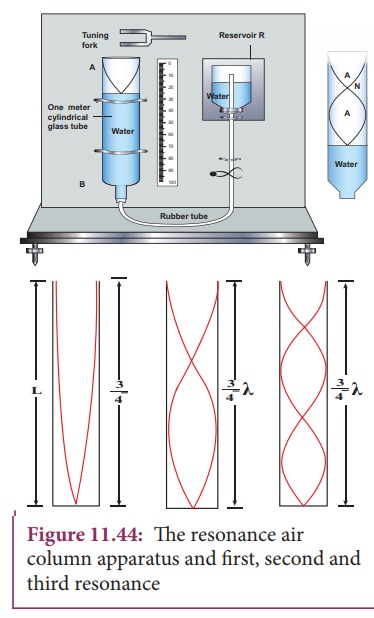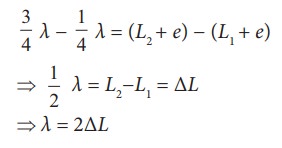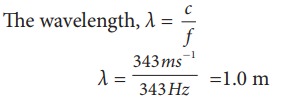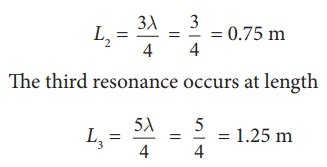Physics - Resonance air column apparatus | 11th Physics : UNIT 11 : Waves
Chapter: 11th Physics : UNIT 11 : Waves
Resonance air column apparatus
Resonance
air column apparatus

The
resonance air column apparatus is one of the simplest techniques to measure the
speed of sound in air at room temperature. It consists of a cylindrical glass
tube of one meter length whose one end A is open and another end B is connected
to the water reservoir R through a rubber tube as shown in Figure 11.44. This
cylindrical glass tube is mounted on a vertical stand with a scale attached to
it. The tube is partially filled with water and the water level can be adjusted
by raising or lowering the water in the reservoir R. The surface of the water
will act as a closed end and other as the open end. Therefore, it behaves like
a closed organ pipe, forming nodes at the surface of water and antinodes at the
closed end. When a vibrating tuning fork is brought near the open end of the
tube, longitudinal waves are formed inside the air column. These waves move
downward as shown in Figure 11.44, and reach the surfaces of water and get
reflected and produce standing waves. The length of the air column is varied by
changing the water level until a loud sound is produced in the air column. At
this particular length the frequency of waves in the air column resonates with
the frequency of the tuning fork (natural frequency of the tuning fork). At
resonance, the frequency of sound waves produced is equal to the frequency of
the tuning fork. This will occur only when the length of air column is
proportional to (1/4)th of the
wavelength of the sound waves produced.
Let
the first resonance occur at length L1,
then

But
since the antinodes are not exactly formed at the open end, we have to include
a correction, called end correction e,
by assuming that the antinode is formed at some small distance above the open
end. Including this end correction, the first resonance is

Now
the length of the air column is increased to get the second resonance. Let L2 be the length at which the
second resonance occurs. Again taking end correction into account, we have

In
order to avoid end correction, let us take the difference of equation (11.80)
and equation (11.79), we get

The
speed of the sound in air at room temperature can be computed by using the
formula
v = f λ = 2f∆L
Further,
to compute the end correction, we use equation (11.81) and equation (11.82), we
get

EXAMPLE 11.27
A
frequency generator with fixed frequency of 343 Hz is allowed to vibrate above
a 1.0 m high tube. A pump is switched on to fill the water slowly in the tube.
In order to get resonance, what must be the minimum height of the water?.
(speed of sound in air is 343 m s−1)
Solution

Let
the length of the resonant columns be L1, L2 and L3. The
first resonance occurs at length L1

The
second resonance occurs at length L2

and
so on.
Since
total length of the tube is 1.0 m the third and other higher resonances do not
occur. Therefore, the minimum height of water Hmin for resonance is,
Hmin
= 1.0 m − 0.75 m = 0.25 m
EXAMPLE 11.28
A
student performed an experiment to determine the speed of sound in air using
the resonance column method. The length of the air column that resonates in the
fundamental mode with a tuning fork is 0.2 m. If the length is varied such that
the same tuning fork resonates with the first overtone at 0.7 m. Calculate the
end correction.
Solution
End
correction

EXAMPLE 11.29
Consider
a tuning fork which is used to produce resonance in an air column. A resonance
air column is a glass tube whose length can be adjusted by a variable piston.
At room temperature, the two successive resonances observed are at 20 cm and 85
cm of the column length. If the frequency of the length is 256 Hz, compute the
velocity of the sound in air at room temperature.
Solution
Given
two successive length (resonance) to be L1 = 20 cm and L2 = 85 cm
The
frequency is f = 256 Hz
v = f λ = 2f∆L
= 2f (L2 − L1)
=
2 × 256 × (85 − 20) × 10−2 m s−1
v= 332.8 cm−1
Related Topics